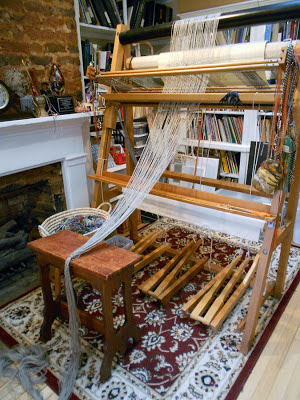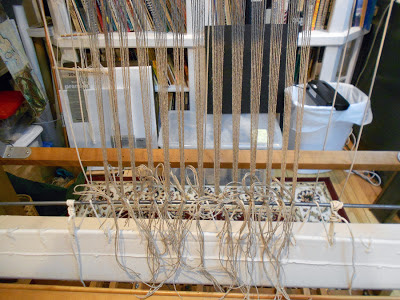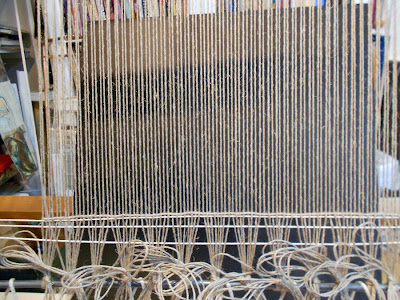I'm using an upright loom that has two harnesses or shafts, with wire heddles. I've also tied old onto new on another tapestry loom that has Texsolv heddles so the process can work with various looms. However, you've got to make sure the knots will pass through both reed and heddles easily before committing to the task!
To test that, you can knot together two short lengths of the warp and see how easily the knot can be slipped through both reed and heddle eye. I use an overhand knot rather than a weaver's knot, although a weaver's knot makes a smaller bump... I just can't get the weaver's knot to hold each time--and I certainly don't want knots to begin to come apart as I'm beaming the warp.
 |
| Here's an overhand knot before it's tightened. |
I prepare for tying on a new warp before cutting off the old one. I treadle each shed and either weave a few passes loosely across a few inches below the reed, or I place lease sticks into each shed (that's what I did in this case). Since the loom is an upright loom, I have to tie the lease sticks to the reed and to each other to keep them in place.
 |
| The old warp, loosely knotted below the lease sticks. |
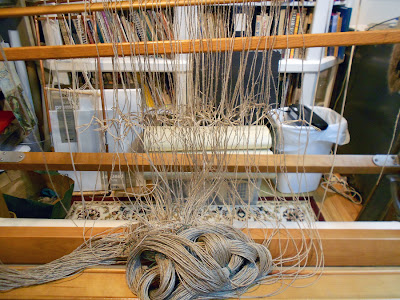 |
| All the new warps are now tied to the ends of the old warp. |
I wind up a bit until the knots are at the reed, then I carefully pull the knots through, a few at a time. Once all the knots have cleared the reed, I wind up a bit more until the knots are approaching the heddles.
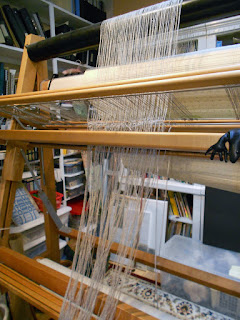 |
| Knots are above the reed now and the heddles are next. |
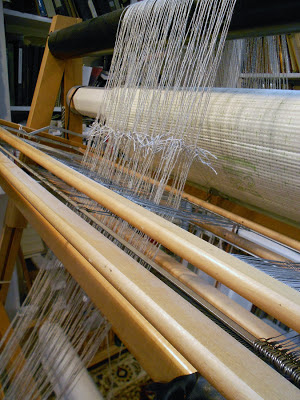 |
| Knots are now through the heddles. |
When the warp is wound up and hanging several inches from the reed, I'm ready to tie onto the cloth beam rod.
For this step, I use only 1" wide amounts for the ties. In fact, I make the edge ties a bit smaller. This warp is sett at 8 epi so all the bouts except the two at each side have eight warps in each tie. The sides have only six ends in the tie on bundles.
When I tie on, I make the center tie first, then each edge. After those, I work alternately from center to each side. I make the tie as a half of the completed slip knot at first, then make the second part of the tie at the second stage, starting in the center and working out to each edge alternately, tightening as I go.
After tying on, I spread out the warp bouts. In this case, I wove in three picks of cotton seine twine, from edge to edge of the loom, pulling each pick very tightly against the frame of the loom. I'm able to use these three picks of foundation with this particular loom since the loom's frame is at the same plane as the warp. The white picks that are seen here are the picks of the seine twine (these foundation picks will be cut free from the loom frame before the warp is wound forward). Below, I'm beginning to spread the warp to the sett that I need.
 |
| I'm working from each side to spread the warps out. I use a bobbin tip to help with this. |
 |
Next, I twine across the width, using the same thread as I've used for the warp.
After the twining, I weave about 1/2" of header, again using the same thread as I've used for the warp.
And, finally... I make a half-hitch across the width before I begin (no photo of that but I explained that in an earlier post... there's a link to that at the left side margin).
That's the set up for the 2013 tapestry diary warp, ready for the new year to come! Here's the entry for yesterday, January 1:
I use an unwoven warp at each side to serve as a visual guide for width... that's the unwoven warp seen at the left side here. Those unwoven warps are left out of the half-hitches, by the way.
